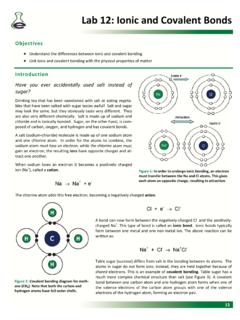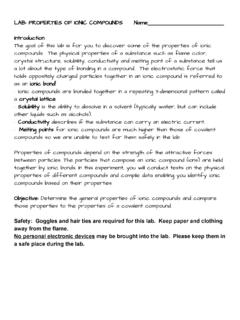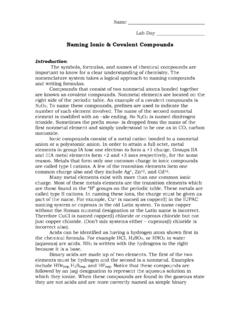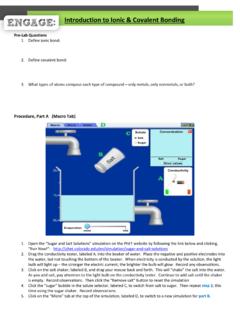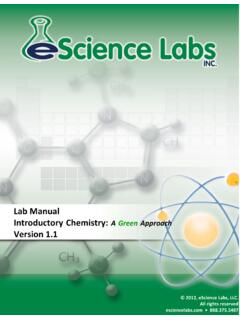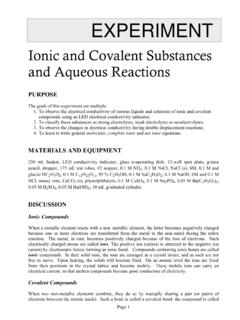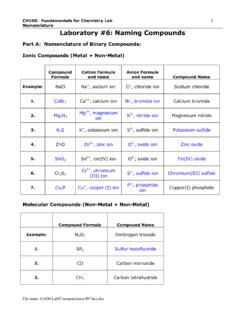Transcription of COVALENT - chemunlimited.com
1 COVALENT COMPOUNDS Chemistry 332 2 Unit 4 ( COVALENT Compounds) 1. Write the electron dot structure (Lewis Dot Structure) for COVALENT compounds or ions. 2. Use electronegativity to determine the polarity of a bond or molecule. 3. Given the formula of a COVALENT compound, write its correct name; given the name of a COVALENT compound, write its formula. 4. Describe the attractive forces between ions, polar molecules, and nonpolar molecules. Unit 4 ( COVALENT Compounds) COVALENT Bond, Octet Rule, Lewis Dot Structure/Intramolecular Bond, Intermolecular Force, Polar, Non-polar, Solubility 3 COVALENT COMPOUNDS COVALENT compounds are made from two non-metals and so don t follow the normal ionic rules. You can tell if a compound is COVALENT because it has prefixes modifying the species names.
2 These species tell you exactly how many atoms are in the COVALENT compound. The prefixes are 1 = mono 2 = di 3 = tri 4 = tetra 5 = penta 6 = hexa 7 = hepta 8 = octa 9 = nona 10 = deca All you have to do is write the species in the compound together, and add a subscript based on the numbers above: nitrogen dioxide: NO2 dinitrogen monoxide: N2O phosphorus pentachloride: PC15 sulfur hexafluoride: SF6 diphosphorus pentoxide: P2O5 Most organic compounds that contain alcohol (R-OH) or carboxylic acid (R-COOH) functional groups will most likely be soluble due to the hydrogen bonding capabilities of those substances. Other COVALENT compounds tend to be insoluble in water. Most organic and COVALENT compounds will not conduct electricity in water. The exception to this rule are organic acids (carboxylic acids).
3 4 Chemistry 332 Name _____ COVALENT Naming I. Name the following compounds. 1. N2O5 _____ 2. SeBr6 _____ 3. CH4 _____ 4. C6H6 _____ 5. PF6 _____ 6. BF3 _____ 7. P2l4 _____ 8. S2Cl3 _____ 9. NO2 _____ 10. P2O5 _____ 11. OF2 _____ 12. CO _____ 13. BrO3 _____ 14. BN _____ 15. CBr4 _____ 5 II. Please write the formulas the formulas for the following compounds. 1. Dihydrogen monoxide _____ 2. Phosphorus trihydride _____ 3. Dinitrogen trioxide _____ 4. Carbon tetrachloride _____ 5. Carbon dioxide _____ 6. Trinitrogen tetroxide _____ 7. Dinitrogen monoxide _____ 8. tetraphosphorus decaoxide _____ 9. Selenium trioxide _____ 10. Iodine heptafluoride _____ 11. Sulfur hexafluoride _____ 12. Sulfur dichloride _____ 13.
4 Disilicon hexabromide _____ 14. Dichlorine heptaoxide _____ 15. Pentaphosphorus decoxide _____ 6 Chemistry 332 Name _____ COVALENT Compounds 1. Name the following compounds. AsF5 OF2 TeF4 CCI4 CO H2Se PH3 SeO2 PI3 2. Write the formulas for the following compounds. Disulfur dichloride nitrogen trihydride Silicon tetroxide nitrogen dioxide Arsenic tribromide tetraphosphorus hexoxide diphosphorus pentoxide sulfur dioxide carbon tetrabromide disulfur pentoxide 7 Chemistry 332 Name _____ Modeling Lewis Dot Structures Directions: Complete the missing information on the data table below. Construct a model for any compounds that have an asterisk (*) next to their name.
5 The key below will designate the appropriate color for ach element. Element Color Hydrogen white Carbon black Oxygen/sulfur/selenium red Nitrogen blue Halogens green (small) Chemical Name Formula Valance Electrons # of Dashes Lewis Dot Structure Carbon dioxide CO2 C 4 O - 12 8 O = C = O ammonia * NH3 methane * CH4 propane * C3H8 hydrochloric acid * HCl ethane * C2H4 carbon tetrachloride * bromine gas * PBr3 8 Lewis Dot Structures (Side 2) Directions: Completer the data table below. It is not necessary to construct any models. Formula Valance Electrons # of Dashes Lewis Dot Structure NCl3 SiS2 HSiN CF2Cl2 GeH4 CSF2 SeCl2 AsF3 C2Br2 Cl2 H2O CH2O CF4 9 Name _____ Lewis Dot Structures Worksheet #1 Homework Problems 1.
6 CO2 2. H2O 3. H2CO 4. HI 5. NH3 6. HCCH 7. CH4 8. CH2F2 9. SeF2 10. HCN 10 Name _____ Lewis Dot Structures Worksheet #2 Homework Problems 1. HC1 2. C1CN 3. CS2 4. H2S 5. N2 6. Br2 CCBr2 7. NI3 9. CF4 10. H3 COH 11 Lewis (Electron) Dot Formulas 5 Easy Rules 1. Determine Arrangement Place the least electronegative atom in the center. The halogens and hydrogen can never be in the center. 2. Determine total number of valence electrons. Two electrons are represented by one dash. (add for negative ions, subtract for positive ions) 3. Attach central atom to surrounding atoms. Molecule should be symmetrical.
7 4. Distribute remaining electrons. 5. Use double or triple bonds if necessary. Hydrogen and the halogens can never have a double or triple bond. 12 Table of Electronegativity Values 1 A 2 A 3 A 4 A 5 A 6 A 7 A 8 A H He Li Be B C N O F Ne Na Mg Al Si P S Cl Ar K Ca Ga Ge As Se Br Kr Rb Sr In Sn Sb Te I Xe Cs Ba Tl Pb Bi Po At Rn Fr Ra Differences in Electronegativity COVALENT Non-polar = 0 COVALENT Polar = and above ionic = Contains a metal 13 B6polar Name _____ Polarity w/s Given the molecules below, identify those which are polar and which are nonpolar. Then identify which ones form hydrogen bonds with like molecules. 14 Name _____ Investigating Some Properties of Water A water molecule is formed when two hydrogen atoms are bonded to a single oxygen atom.
8 Because of the structures of the atoms involved, a bent molecule is formed. The bond between each hydrogen and the oxygen atom is formed by the sharing of a pair of electrons. The electrons are not shared equally between the two atoms. The oxygen atom has greater attraction for the shared pair of electrons so it keeps them closer to itself. The unequal sharing causes the oxygen atom to have a partial negative charge ( -) while the hydrogen atoms will have a partial positive charge ( +). Because the partially negative oxygen and partially positive hydrogen s are arranged in a bent shape, the water molecule has a positive side and a negative side; it is called a polar molecule or dipole.
9 This polarity causes the water molecules to be attracted to each other. The positive side of one molecule is attracted to the negative side of another molecule. This intermolecular attraction (shown by the lighter lines) is weaker than the COVALENT bonds which hold the hydrogen and oxygen atoms together in each molecule, but is strong enough to affect the properties of water. In this lab you will investigate some properties of water by comparing water s behavior to that of hexane in several situations.
10 Hexane is a non polar molecule because of the very uniform arrangement of the atoms in the molecule. Hexane H H O 15 Name _____ Investigating Some Properties of Water PLW 1. Draw the molecular structure of water and label the partial charges of each element. 2. Why is the water molecule s shape bent and not linear? 3. How does the shape of the water molecule determine its polarity? 4. Define hydrogen bonding. 5. Using class notes, describe intermolecular bonds. 6. Draw the structure of hexane and describe its polarity. 16 Name _____ Water & Cyclohexane Lab Questions Table 1: Rate of evaporation Explain in detail why the drop of cyclohexane evaporated faster than the drop of water.

